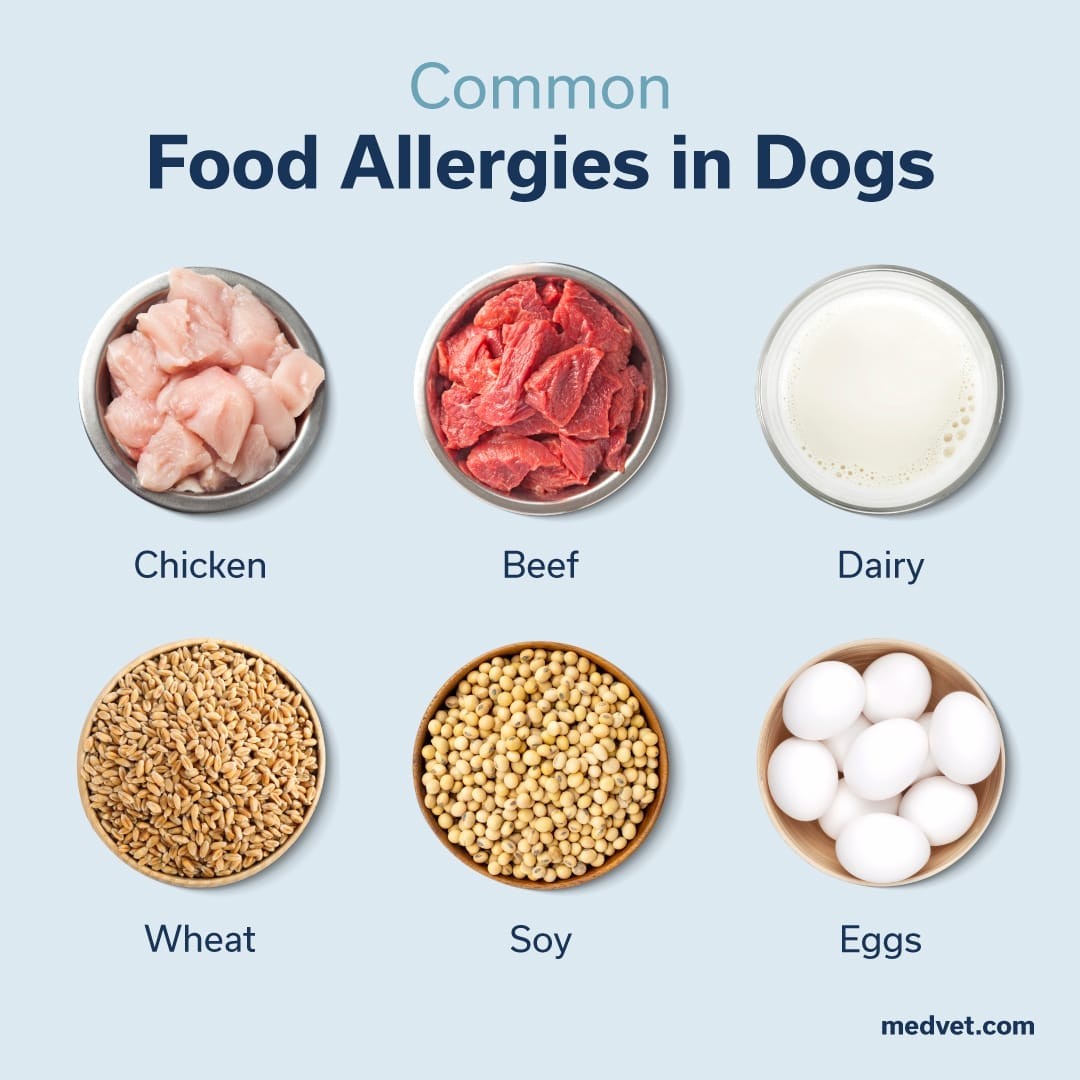Even if your dog has enjoyed the same food for years, they can still develop food allergies. This happens because their immune system can develop antibodies to specific ingredients over time. If you suspect your furry friend might have a food allergy, it’s essential to recognize the signs and seek veterinary guidance.
What are Food Allergies in Dogs?
Food allergies in dogs, also known as Cutaneous Adverse Food Reactions (CAFR), occur when their immune system mistakenly identifies a food ingredient, usually a protein, as a threat. This overreaction triggers an immune response, leading to various uncomfortable and sometimes serious symptoms. It’s important to distinguish food allergies from food intolerances, which don’t involve the immune system and usually cause gastrointestinal upset.
Food allergies are less prevalent than environmental allergies in dogs, such as reactions to pollen, fleas, and dust mites.
Signs of Food Allergies in Dogs
Recognizing the signs of food allergies is the first step in getting your dog the help they need. The symptoms can vary, but some common indicators include:
- Persistent Itching: This is often the most noticeable symptom. Dogs may scratch, lick, or chew excessively at their skin, particularly around their paws, face, ears, and groin.
- Skin Problems: Redness, inflammation, rashes, and hot spots can develop as a result of constant scratching and irritation.
- Recurrent Ear Infections: Food allergies can contribute to chronic ear infections due to inflammation and changes in the ear canal environment.
- Gastrointestinal Issues: Vomiting, diarrhea, excessive gas, and changes in appetite can also indicate a food allergy.
These symptoms can overlap with other conditions, such as environmental allergies or parasitic infections. Therefore, consulting with a veterinarian is crucial for accurate diagnosis.
Common Food Allergies in Dogs
While dogs can develop allergies to virtually any food ingredient, some are more common culprits than others. These include:
- Chicken
- Beef
- Dairy products
- Wheat
- Soy
- Eggs
It’s also possible for dogs to be allergic to multiple ingredients.
How to Know if Your Dog Has Food Allergies: The Elimination Diet Trial
The gold standard for diagnosing food allergies in dogs is an elimination diet trial. This involves feeding your dog a specially formulated diet that excludes all ingredients they have previously been exposed to. The goal is to see if their symptoms improve when the potential allergens are removed. This trial typically lasts for at least eight weeks and must be closely supervised by a veterinarian.
There are two main types of diets used for elimination trials:
- Novel Protein Diets: These diets contain a single protein source that your dog has never eaten before, such as venison, rabbit, or duck.
- Hydrolyzed Protein Diets: These diets contain proteins that have been broken down into smaller pieces, making them less likely to trigger an allergic reaction.
It is important to note that over-the-counter diets often aren’t suitable for elimination trials due to potential cross-contamination. Prescription diets from your veterinarian are usually recommended.
Blood tests, saliva tests and hair tests marketed to diagnose food allergies in pets are generally inaccurate and unreliable. A properly conducted food trial, under veterinary guidance, remains the most effective diagnostic tool.
What Happens During a Food Trial for Dogs
Your veterinarian or a veterinary dermatologist will guide you through the process of conducting a food trial for your dog. It’s crucial to adhere strictly to the prescribed diet and water. Make sure any monthly preventatives, such as heartworm and flea medications, are unflavored.
Here are some essential tips for a successful food trial:
- Thoroughly Clean Food Bowls: Before starting the trial, wash all food bowls with soap and water to remove any traces of previous food.
- Separate Pets During Feeding: Ensure that all family pets are separated during feeding times to prevent cross-contamination. Pick up the bowls immediately after feeding and don’t allow the dog on the trial to access other pets’ food. Consider putting all pets on the trial diet to avoid problems.
- Gradually Introduce the New Diet: Over three to seven days, slowly transition your dog to the new diet. Start by mixing small amounts of the new food with their old food, gradually increasing the proportion of the new food. Keep a small supply of the original diet on hand for a potential rechallenge.
- Strictly Avoid Treats and Other Potential Allergens: Do not give any treats, flavored medications, supplements, bones, or other potential sources of allergens during the trial. Use only topical or unflavored preventatives. Consult your veterinarian about which fruits and vegetables are safe to offer in moderation.
- Avoid Giving Medications in Food: Do not administer medications in food, treats or pill pockets. Always consult your veterinarian or veterinary dermatologist before giving any supplements or medications during the food trial.
Diagnostic food trials typically last eight weeks, as it takes approximately four weeks for the immune system to adjust to the new diet and up to eight weeks to observe improvements in your dog’s symptoms.
Based on the results of the food trial, a rechallenge may be necessary. A rechallenge involves reintroducing the original diet to see if the symptoms return. If they do, this confirms a food allergy.
In some instances, a veterinary dermatologist might recommend reintroducing individual ingredients to precisely identify the specific allergen. During this process, the dog continues on the trial diet while each ingredient is reintroduced for 10-14 days, allowing for observation of any flare-ups.
The reintroduction phase may include meats (chicken, turkey, beef, etc.), grains (rice, oat, wheat, etc.), dairy products (milk, cheese), and eggs.
Treating Food Allergies in Dogs
Once the offending allergen has been identified, the most crucial step is to avoid all foods, treats, and supplements containing that ingredient. Be aware that even pet foods labeled as “limited-ingredient” may not be suitable due to the risk of cross-contamination during manufacturing.
In addition to dietary management, your veterinarian may prescribe medications to help manage your dog’s symptoms. These might include antihistamines, allergy medications such as Apoquel or Cytopoint, or steroids. Omega-3 fatty acid supplements can also be beneficial for supporting skin health and reducing inflammation.
Regular follow-up appointments with your veterinarian are essential for monitoring your dog’s progress and making necessary adjustments to their diet or treatment plan.
Conclusion
Identifying and managing food allergies in dogs can be a challenging but rewarding process. By recognizing the signs, working closely with your veterinarian to conduct a proper elimination diet trial, and carefully managing your dog’s diet, you can significantly improve their quality of life and help them live a more comfortable, itch-free life. Remember that consistent communication with your vet is key to successful management.

